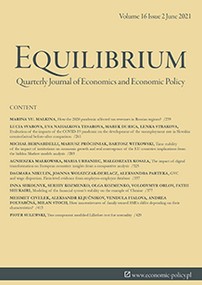Evaluation of the impacts of the COVID-19 pandemic on the development of the unemployment rate in Slovakia: counterfactual before-after comparison
Evaluation of the impacts of the COVID-19 pandemic on the development of the unemployment rate in Slovakia: counterfactual before-after comparison
Author(s): Lucia Svabova, Eva Nahalkova Tesarova, Marek Ďurica, Lenka StrakovaSubject(s): National Economy, Labor relations, Health and medicine and law, Socio-Economic Research
Published by: Instytut Badań Gospodarczych
Keywords: unemployment; labour market; COVID-19; counterfactual evaluation;
Summary/Abstract: Research background: The COVID-19 pandemic, which hit the world in the first quarter of 2020, has impacted almost every area of people's lives. Many states have introduced varying degrees of measures to prevent its spread. Most of these measures were, or still are, aimed at reducing or completely stopping the operation of shops and services, or in some cases, also the large manufacturing companies. However, as many companies have failed to cope with these restrictions, unemployment has risen in almost all EU countries. A similar situation was also observed in Slovakia, where the mentioned measures also had a significant impact on unemployment. Purpose of the article: In this study, we deal with the quantification of the impact of a pandemic, or more precisely, anti-pandemic measures, on the development of the registered unemployment rate in Slovakia. Methods: This quantification is based on the counterfactual method of before-after comparison, which is one of the most widely used methods in the field of impact assessments and brings very accurate results, based on real data. In the analysis, we use officially published data on the unemployment rate in Slovakia during the years 2013–2020 on a monthly basis. Such a long time series, using statistical methods of its decomposition and modelling of its trend, will allow predicting the development of the unemployment rate in Slovakia, assuming a counterfactual situation of no pandemic, and compare this development with the actual situation that occurred during 2020. Findings & Value added: The study results indicate an increase in the unemployment rate in Slovakia during 2020 by 2–3% compared to the trend of its development, which would have occurred without a pandemic. Given the counterfactual method used, this difference can be described as the impact of the COVID-19 pandemic. The results of the study can be used in practice in the design and implementation of measures introduced to mitigate the impacts of the pandemic on unemployment and, in the long-term perspective, also to eliminate these effects as much as possible. It can also be used as a theoretical tool in conducting impact assessments, which have so far been carried out very rarely in Slovakia.
Journal: Equilibrium. Quarterly Journal of Economics and Economic Policy
- Issue Year: 16/2021
- Issue No: 2
- Page Range: 261-284
- Page Count: 24
- Language: English

